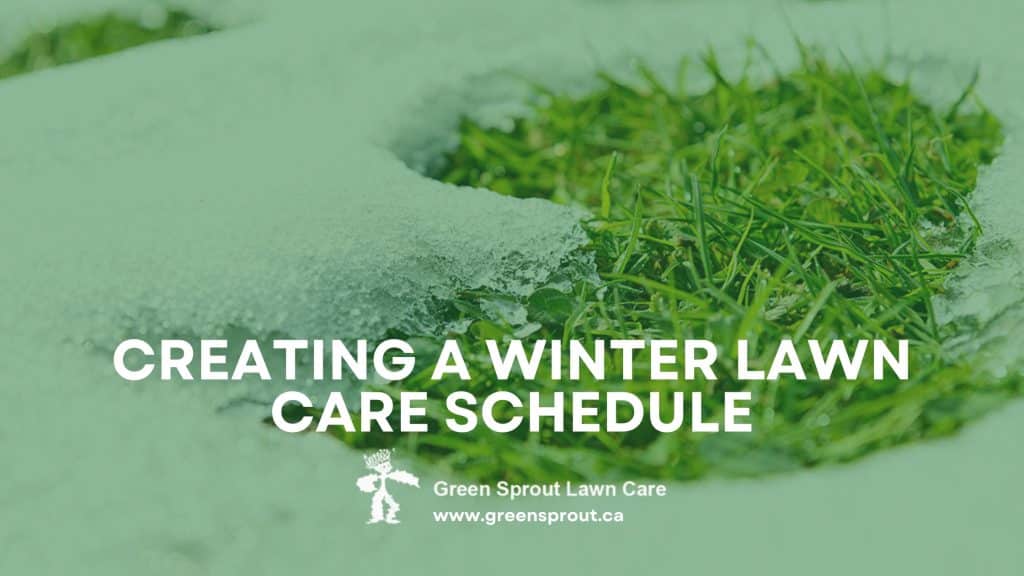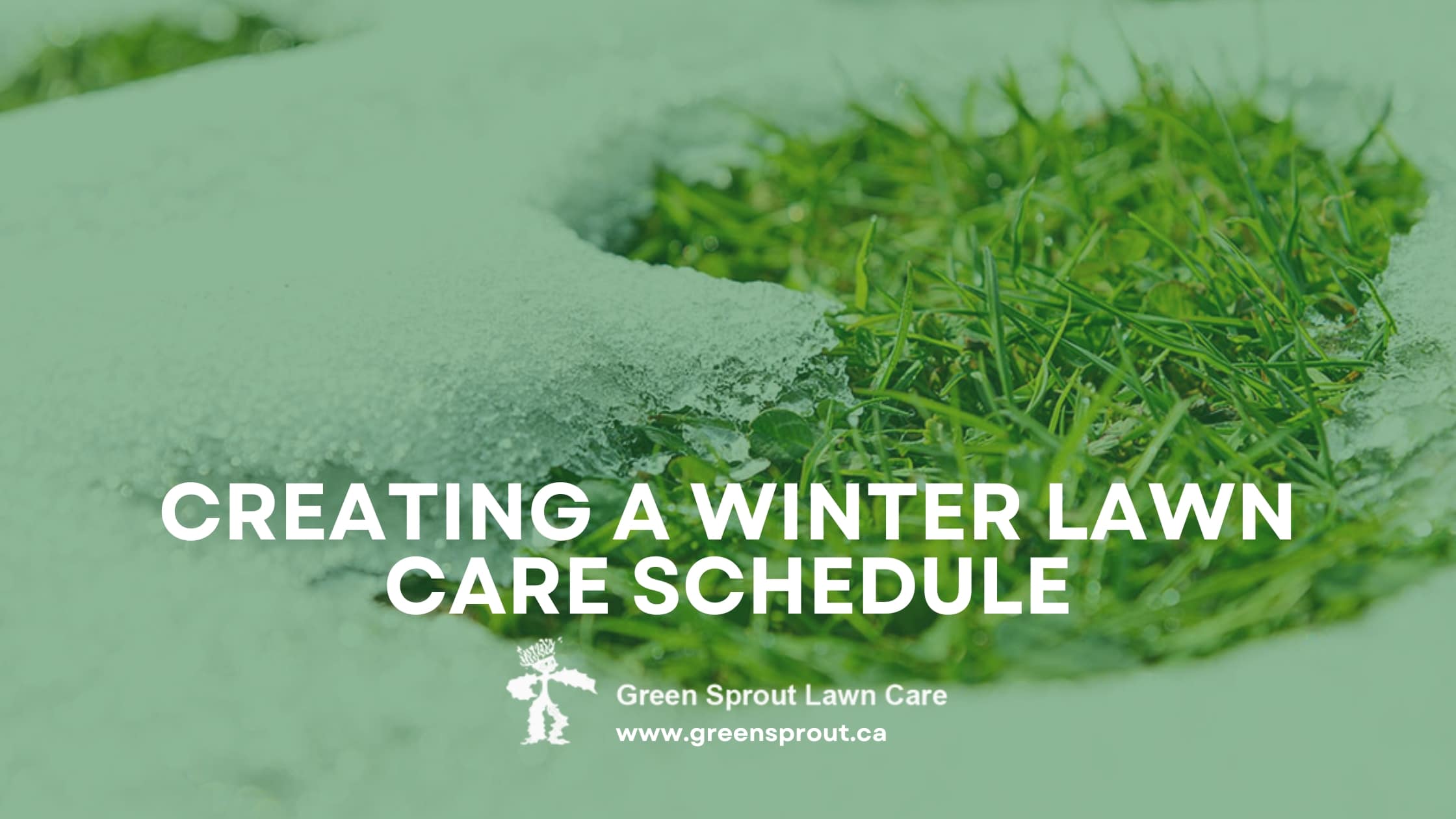Mastering Winter Lawn Care: A Comprehensive Guide for Edmonton Homeowners
Maintaining a lush and healthy lawn in Edmonton’s harsh winter climate requires careful planning and timely action. As the temperatures drop and snow blankets the ground, it is easy to assume that lawn care takes a back seat until spring. However, proper winter lawn care is essential to prepare it for survival during the winter and get it back in shape vigorously once the warmer months arrive.
We have put together a comprehensive guide to creating a winter lawn care schedule tailored to Edmonton’s unique climate in order to help you overcome the challenges of winter lawn care.
1. Late Fall: Preparing for the Freeze
Before the first snowfall, there are crucial steps to take to prepare your lawn for the coming winter:
Aeration and Overseeding (Late September – Early October):
This is the right period to start lawn aeration and overseeding. September with its cooler temperatures and increased moisture has the right conditions for rejuvenation of cool-season grasses like rye and blue grasses. In the fall months, shoots start to grow again and nutrients are stored in the long roots for the winter. Aerating the soil improves water and nutrient penetration, while overseeding helps fill in thin areas. This process promotes healthy grass growth when spring sets in. Seed-to-soil contact can be improved by core aerating before spreading seed.
Fertilization (Late October):
Fertilization helps to improve poor quality grass or maintain good quality grass more than any other single management practice. Two applications of fertiliser are ideal in the fall. The first application should be made in early fall. Apply a slow-release, winter-specific fertilizer e.g., nitrogen and potash, to provide essential nutrients for your grass. This strengthens the roots and ensures a strong start once temperatures rise.
Dethatching (Early October)
Thatch carries disease-causing organisms such as snow mould. Lawns with an abundance of thatch are more prone to winter injury. This is the ideal period for thatch control. It is carried out in two major ways – core aeration and dethatching. Core aeration works by breaking up the thatch and bringing up soil, which contains microorganisms, that help break down the thatch. De-thatching is done by a machine that cuts into the thatch vertically, bringing up the debris, which is then raked up and disposed of.
Mowing (Late October):
Before the winter sets in, trim the lawn grass to a shorter height. Long grass can trap moisture and lead to winter fungal diseases and snow mould. It can also suffocate your lawn in the spring making it harder to recover from the winter. Shorter grass is stiff and more resistant to ice and snow damage
2. Early Winter: Protecting Against Frost and Snow Mold
As winter deepens, your focus should shift to protecting your lawn from frost and snow mould:
Leaf Cleanup (Late October – November):
Clear fallen leaves to prevent them from smothering the grass and promoting snow mould growth. Alternatively, mulching the leaves with a mulching mower can provide natural insulation. By mulching the leaves into small bits, you allow the leaves to decompose easier, thus providing valuable nutrients to the grass blades.
Snow Mould Prevention (November):
Apply a preventive fungicide to prevent the growth of snow mould, a common cold-weather lawn disease. This step is especially important in areas with heavy snowfall like Edmonton which makes it particularly susceptible to snow mould.
3. Mid-Winter: Minimizing Traffic and Compaction
With winter in full swing, your lawn enters a period of dormancy. The goal now is to minimize any damage while the grass lies dormant:
Keep the lawn clear throughout the Winter:
Do not leave anything behind on the lawn. Put away sprinklers, hoses, garden furniture, yard toys and decorations. If something is left on lawn surface, the grass will get matted down during the winter months. With the added moisture of rain and snow, this can also make the perfect environment for pests and mould infestation which could damage the lawn.
Keep Off the Lawn:
Avoid walking on the lawn as much as possible, especially when it is frozen. This can compact the lawn and kill the grass. Never allow anyone to park a truck or a car on your lawn. Using the lawn as a parking lot is the fastest way to kill the good grass and make room for crabgrass and other types of weeds.
Clear Snow Accumulation:
Gently remove snow from high-traffic areas like driveways to prevent compaction and damage. Heavy piles of snow can cause stress to the lawn and waterlogging can set in as large piles melt. Use a plastic shovel or a snow blower set at a high height to avoid scraping the grass.
4. Late Winter: Preparing for Spring Awakening
As the end of winter approaches, your focus turns to preparing your lawn for the eventual transition to spring:
Monitor Moisture Levels (February – March):
In case of a winter thaw, be vigilant about moisture levels. Waterlogged soil can lead to disease. Ensure proper drainage and avoid overwatering. Check out low spots where puddles keep the soil wet. Fill holes and puddles with compost or topsoil or provide drainage so excess water does not stand on the lawn.
Inspect for Rodent Damage (March):
In the last weeks of winter, check for signs of rodent activity. Rodents can cause damage to grass and plants during winter foraging.
5. Early Spring: Transitioning to Active Growth
As the snow begins to melt and temperatures rise, your lawn slowly awakens from its winter slumber. Taking the time to help your lawn wake up properly when spring arrives reduces problems later.
First Mowing (Late March – Early April):
As soon as the soil dries out a bit and the grass begins to grow, mow it gently to remove any dead growth and allow sunlight to reach the soil.
Raking (Late March – Early April):
Lightly rake the lawn in the early spring to remove any remaining debris and promote even growth. Remember to be gentle, as the grass is still fragile. Carefully clear away leaves and dead grass. This will break up any matted areas caused by snow mould which can smother new growth.
Wash Away Any Salt Residue (Late March – Early April):
At the beginning of spring, hose down your garage, driveway, sidewalk and even the edges of your lawn to ensure its salt free. The salt and other de-icing products used to clear roads and sidewalks can pile up in your lawn over the winter, causing damage to vulnerable grasses. Give your late winter lawn a good rinse to flush out salts and prepare your grass to absorb its spring treatments.
Core Aeration (Early April):
Follow up with another round of aeration to further improve soil health and promote strong root growth. Aerating the lawn in the early spring can help improve drainage and allow the grass to get the nutrients and water it needs to grow. It prevents the grass from getting too compacted during the spring and summer.
Fertilization (Early April):
Apply a balanced, slow-release fertilizer to kick-start active growth. This helps your lawn recover faster from the onslaught of the harsh winter. After aerating, as soon as the snow melts and the soil temperatures start warming up, give your grass a feed to energize growth for the spring. Lawn fertilizer is a special mix of nutrients that is absorbed by the roots and used as food by the plant over a period over time.
In conclusion, the winter is a harsh challenge for any lawn. Drawing up a winter lawn care schedule for your Edmonton property involves careful consideration of the local climate and understanding the specific needs of your grass type. By adapting the above guidelines to your lawn’s unique characteristics, you can make sure that your lawn emerges from winter healthier, stronger and ready to thrive in the coming growing season. Remember, a little winter care goes a long way in nurturing a beautiful lawn all year round.


